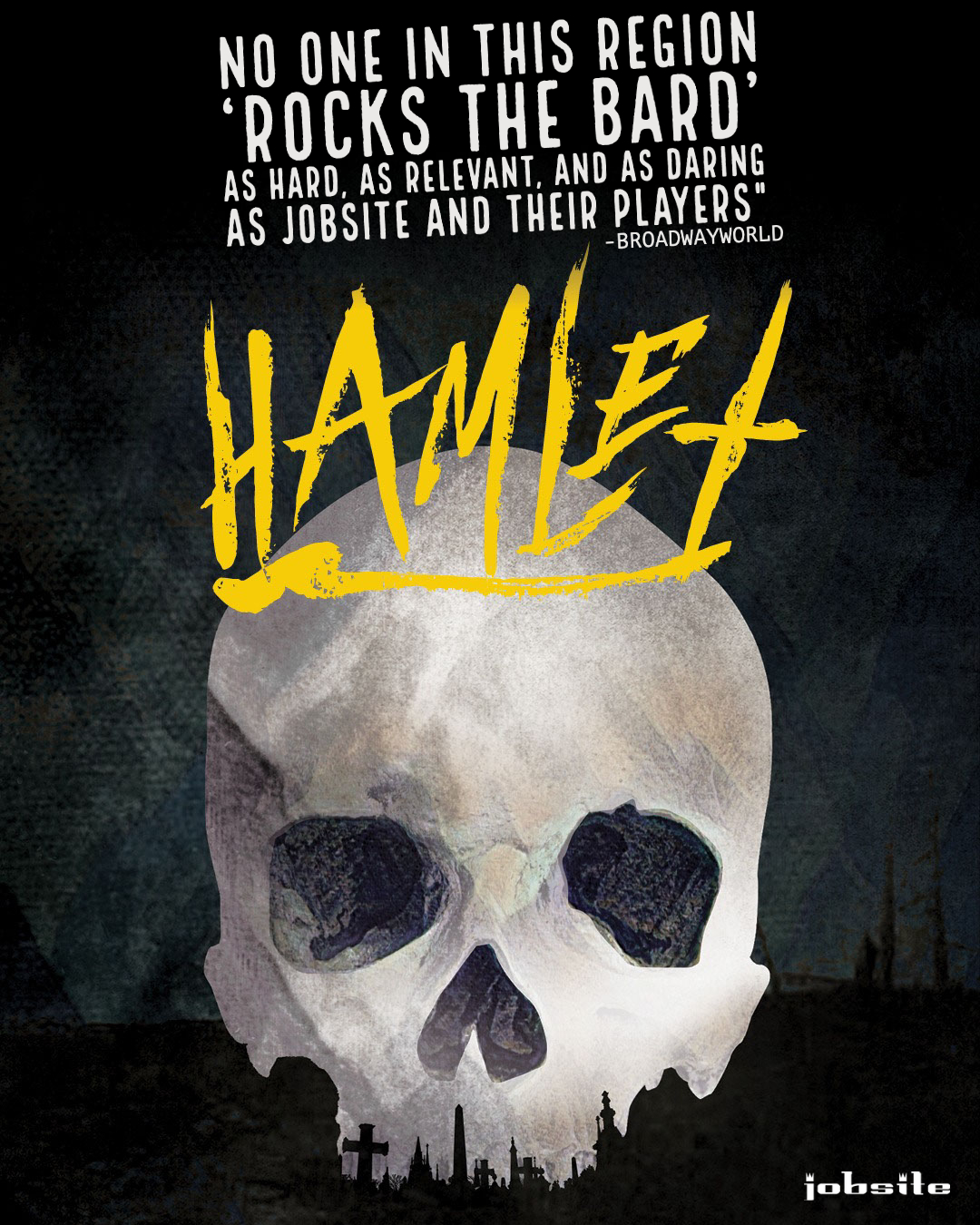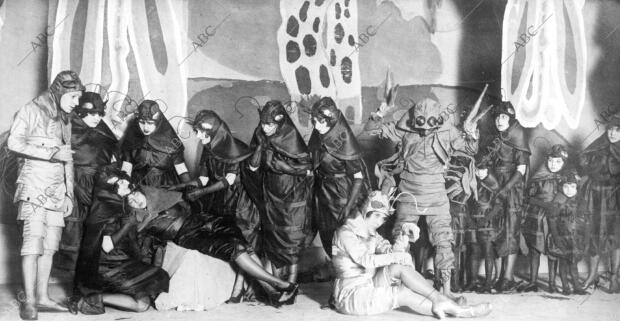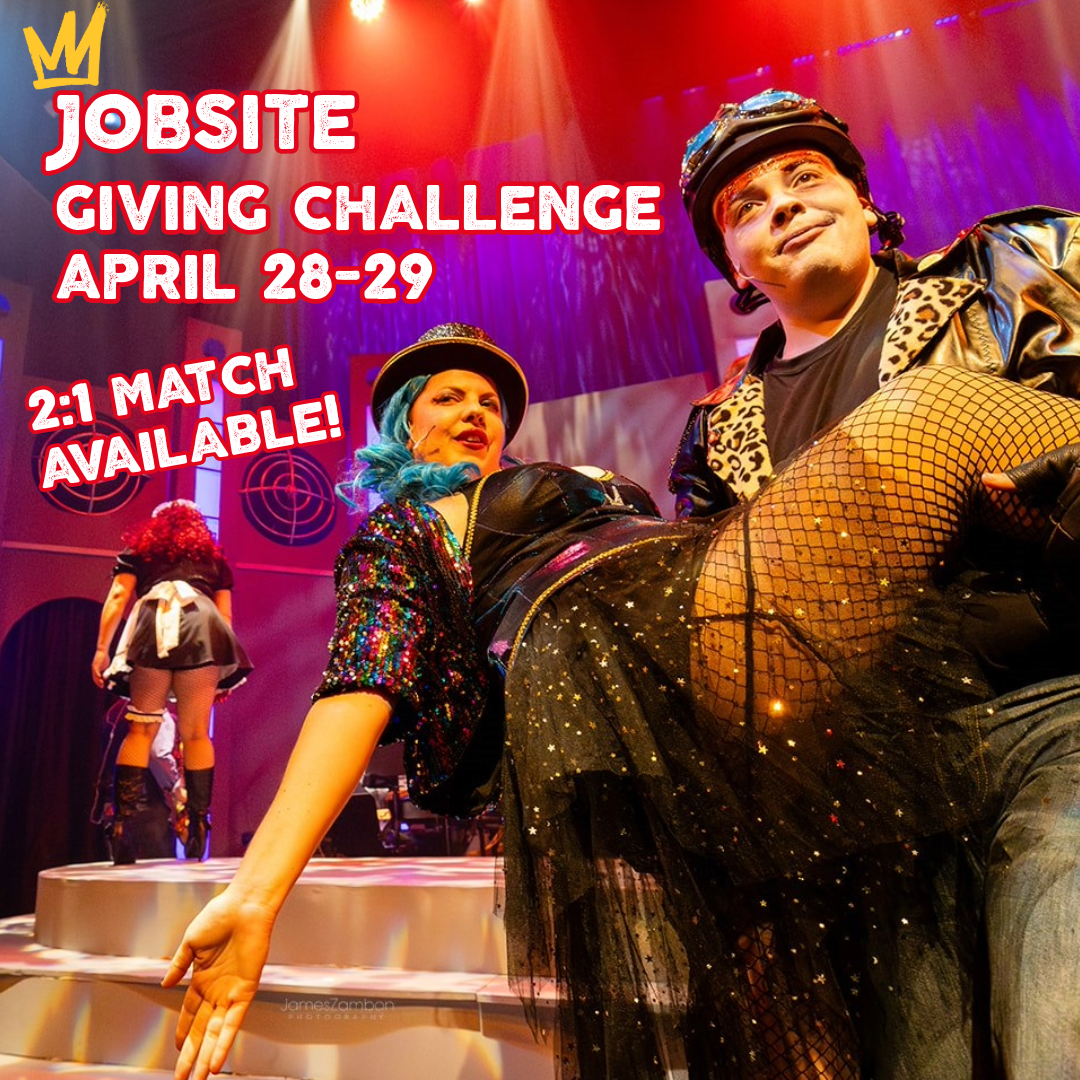I got this in a response to my weekly email, and intend on answering it in a way that does not need cuts of its own! 🙂
“I’m looking forward to seeing Hamlet on Jan. 19th with friends as part of my season’s pass. Your comment about the runtime for Jobsite’s production had me searching online for clues about what modern directors cut from a play that’s 4,000+ lines. I found nothing. Must be a closely guarded secret, lol. Two hours, 15 min is closer to the “two hours’ traffic of our stage” promised in Romeo and Juliet. Can you write a few words about how you’ve gone about it, or is that all in the liner notes? Many thanks in advance.”
 If anything, I’m usually only ever asked things like if we’re doing Shakespeare “in real English” or if we’re going to “modernize the language,” and the answers to those are “it’s always been in real English,” and “no, because at that point we’re writing a new play and not doing Shakespeare.”* Not that anything is wrong with taking a Shakespeare play and making it something else, also see: Westside Story, & Juliet, Teenage Dick, Ten Things I Hate About You, etc. Our Shakespeare program is dedicated to doing the actual plays as complete as we can considering what we may be up against.
If anything, I’m usually only ever asked things like if we’re doing Shakespeare “in real English” or if we’re going to “modernize the language,” and the answers to those are “it’s always been in real English,” and “no, because at that point we’re writing a new play and not doing Shakespeare.”* Not that anything is wrong with taking a Shakespeare play and making it something else, also see: Westside Story, & Juliet, Teenage Dick, Ten Things I Hate About You, etc. Our Shakespeare program is dedicated to doing the actual plays as complete as we can considering what we may be up against.
When cutting Shakespeare, there are technical considerations that usually come first, you can’t just chop Willy-nilly (seewutidid?). Shakespearean verse is in iambic pentameter, which is a fancy way of saying 10 beats within the line (five pairs of unstressed/stressed syllables) that give it that “Shakespeare” sound (ba DUM/ba DUM/ ba DUM/ba DUM/ ba DUM), his “heartbeat.” For example, Hamlet’s line “In sooth, I know not why I am so sad” scans:
in SOOTH/ i KNOW/ not WHY/ i AM/ so SAD.
The first thing we try to do is to maintain Shakespeare’s “heartbeat” in the rhythm by cutting entire lines or, if cutting internally, to find the ways to make it agree — keeping 10 beats per line. Sometimes that might even mean ending character A’s line after the 6th beat then finding the way for character B to get the last 4.
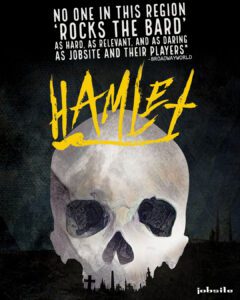 A rule of thumb for the runtime of a Shakespeare play in performance is an hour per thousand lines of verse. Hamlet, if you use the Folger cut, is 4,167 lines, or close to 4.25 hours without an intermission. It would be hard to ask a modern audience to sit through a show over 4.5 hours, and impossible to ask of schools coming on a weekday field trip, so my goal was to get it under 2.5 hours with the intermission — no more than 2,250 lines. Our cut sits just under 2,100 lines at this point, and we believe our total runtime to be around 2:15-2:20 with intermission based on our table reads.
A rule of thumb for the runtime of a Shakespeare play in performance is an hour per thousand lines of verse. Hamlet, if you use the Folger cut, is 4,167 lines, or close to 4.25 hours without an intermission. It would be hard to ask a modern audience to sit through a show over 4.5 hours, and impossible to ask of schools coming on a weekday field trip, so my goal was to get it under 2.5 hours with the intermission — no more than 2,250 lines. Our cut sits just under 2,100 lines at this point, and we believe our total runtime to be around 2:15-2:20 with intermission based on our table reads.
How did we get there? Here are the major factors that go into cuts:
To thine own self be true
Remember, this ain’t the Bible. It’s perfectly acceptable to cut his plays. Tell your story, get in there and have fun.
Resources
 Not only is time money, but so are people. For us to go over 2.5 hours would put us into overtime for the union stagehands (who arrive 1.5 hours before the show), and I was hoping to find a way to cut the cast to 10 people to help us stay in a safe budget (actors are paid weekly for rehearsals and performances, and we are limited to 20 hours a week of work across 5 days). These factors cemented my need to get the text to a certain length, and to look for what roles could be trimmed.
Not only is time money, but so are people. For us to go over 2.5 hours would put us into overtime for the union stagehands (who arrive 1.5 hours before the show), and I was hoping to find a way to cut the cast to 10 people to help us stay in a safe budget (actors are paid weekly for rehearsals and performances, and we are limited to 20 hours a week of work across 5 days). These factors cemented my need to get the text to a certain length, and to look for what roles could be trimmed.
 You can do most of Shakespeare’s plays with a cast of 13 if you are ok with doubling roles (as Shakespeare did). Knowing I wanted 10, I looked for who could be cut without messing with the plot. I combined many of the messengers, servants, and courtiers into tracks for two actors, absorbed into the roles of Marcellus and Barnardo. This allowed me to cut certain interactions outright, or fold them into one of those previously mentioned characters. Bye-bye Osric, Reynaldo, Francisco, Cornelius, and the second Gravedigger. Combining characters into a single role played by one actor is also less confusing for an audience member who might otherwise think “oh, wait, is that dude another dude now or the same dude with a beard?”
You can do most of Shakespeare’s plays with a cast of 13 if you are ok with doubling roles (as Shakespeare did). Knowing I wanted 10, I looked for who could be cut without messing with the plot. I combined many of the messengers, servants, and courtiers into tracks for two actors, absorbed into the roles of Marcellus and Barnardo. This allowed me to cut certain interactions outright, or fold them into one of those previously mentioned characters. Bye-bye Osric, Reynaldo, Francisco, Cornelius, and the second Gravedigger. Combining characters into a single role played by one actor is also less confusing for an audience member who might otherwise think “oh, wait, is that dude another dude now or the same dude with a beard?”
What story are we trying to tell?
 If you want more or less comedy or drama, more or less room for fancy long fights or songs or dances, other areas of the play may simply become less important. I didn’t want to lose the few bits of humor in this show but there was certainly a lot of politics (the uncertainty of succession that was timely in London when the play was written) and undercurrents of religious debate (Catholic v. Protestant — again, timely around 1600) that weren’t central to the story I wanted to tell. This helped me get rid of second Gravedigger, and made the roles of Fortinbras and Voltemand insignificant — allowing me to cut entire scenes not crucial to the action in Elsinore.
If you want more or less comedy or drama, more or less room for fancy long fights or songs or dances, other areas of the play may simply become less important. I didn’t want to lose the few bits of humor in this show but there was certainly a lot of politics (the uncertainty of succession that was timely in London when the play was written) and undercurrents of religious debate (Catholic v. Protestant — again, timely around 1600) that weren’t central to the story I wanted to tell. This helped me get rid of second Gravedigger, and made the roles of Fortinbras and Voltemand insignificant — allowing me to cut entire scenes not crucial to the action in Elsinore.
 Hamlet, to me, is a ghost story, a detective story, and a revenge tale. Focusing on those and eliminating the Fortinbras/Norway subplot then also allowed me to end the play with Hamlet’s last words to Horatio, and Horatio’s final remarks — a far more impacting ending for the story I wanted to tell.
Hamlet, to me, is a ghost story, a detective story, and a revenge tale. Focusing on those and eliminating the Fortinbras/Norway subplot then also allowed me to end the play with Hamlet’s last words to Horatio, and Horatio’s final remarks — a far more impacting ending for the story I wanted to tell.
What can we expect of a modern audience?
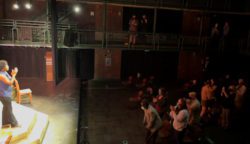 Artists can never forget that our one job is to tell a story to the real humans in front of us who paid good money for an experience. You shouldn’t need a PhD in world history, philosophy, ancient mythologies, etc to follow along. And, let’s be honest, sometimes Shakespeare is making allusions to things that are just completely alien to us now. A lot of that can go. If we leave an audience hanging out there lost for too long, they’ll tune out and we’ll never get them back.
Artists can never forget that our one job is to tell a story to the real humans in front of us who paid good money for an experience. You shouldn’t need a PhD in world history, philosophy, ancient mythologies, etc to follow along. And, let’s be honest, sometimes Shakespeare is making allusions to things that are just completely alien to us now. A lot of that can go. If we leave an audience hanging out there lost for too long, they’ll tune out and we’ll never get them back.
 Shakespeare will often say the same thing 2-3 different ways in the same scene because he was writing for a specific audience. He had varying classes of people in attendance and theater etiquette was worse than anything we can think of now. If he said something once plainly, once incredibly poetically, and maybe once with a bawdy pun he stood a better chance of the information being gleaned saying it 3x in different ways. At Jobsite, we focus on what best sets us up for success — rooted in the story we want to tell — and cut the rest.
Shakespeare will often say the same thing 2-3 different ways in the same scene because he was writing for a specific audience. He had varying classes of people in attendance and theater etiquette was worse than anything we can think of now. If he said something once plainly, once incredibly poetically, and maybe once with a bawdy pun he stood a better chance of the information being gleaned saying it 3x in different ways. At Jobsite, we focus on what best sets us up for success — rooted in the story we want to tell — and cut the rest.
There is a lot of repetition in Shakespeare from one act to the next since he took an intermission after each (five acts total) and he wanted to make sure people remembered or perhaps even got the info for the first time if they weren’t paying attention earlier. There’s even more we can cut in those repetitions.
Some lines served as cues for actors backstage in the Elizabethan theater, or to tell the audience what was going on in lieu of fancy stagecraft (that it was night, or raining, etc). I trust my actors are paying attention backstage, so we can get rid of “But here comes the Queen” and all that.
Does it advance the plot or add to what we’re trying to communicate?
 This can be the hardest part. When the players arrive to Elsinore, Hamlet gives one of the best-known speeches in the play, especially if you’ve been around a theater for a minute, “Speak the speech, I pray you, as I pronounced it to you …” — what we commonly call Hamlet’s advice to the players. It is hands-down the best set of written instructions we have for how to perform Shakespeare — and directly from the man himself.
This can be the hardest part. When the players arrive to Elsinore, Hamlet gives one of the best-known speeches in the play, especially if you’ve been around a theater for a minute, “Speak the speech, I pray you, as I pronounced it to you …” — what we commonly call Hamlet’s advice to the players. It is hands-down the best set of written instructions we have for how to perform Shakespeare — and directly from the man himself.
But does it add anything? No.
It’s nice, it’s thrilling insider baseball even, but it does nothing for the whole. I even tried keeping a chunk of this scene and Giles Davies (Hamlet, and my long-time text coach/expert) came back 2 more times with the red pen and so I finally relented. 🙂
Is it cringe?
 The world was just a different place during the Renaissance. Sometimes Shakespeare employs descriptions or phrases that are just gross today (in Much Ado About Nothing, Claudio says he’ll marry a girl he hasn’t seen even if she’s black as an Ethiopian — yikes).
The world was just a different place during the Renaissance. Sometimes Shakespeare employs descriptions or phrases that are just gross today (in Much Ado About Nothing, Claudio says he’ll marry a girl he hasn’t seen even if she’s black as an Ethiopian — yikes).
Sometimes, too, conversations between men and women are so bogged down in good ol’ fashioned epic patriarchy that it’s hard not to pull a face when either gender is so essentialized. Keeping those bits can easily submarine our chances to get folks invested in the characters and story. If a character is meant to be gross (Iago in Othello), fair go, but I didn’t want the audience to hate Polonius when he speaks to his daughter Ophelia, and so got rid of anything that would come off “oh, you poor dumb girl, shut up and sit down and let a man set you straight.” What remains is still fatherly concern and advice, just not so cringey.
If it plays, it stays, if it don’t …
 The final factor is how a text plays on its feet with the actors, in your specific performance context you have built together, in front of your audience. We’ve been in rehearsal for a week, and have already found some things that simply don’t work with our staging, add to our show, or just simply stick out.
The final factor is how a text plays on its feet with the actors, in your specific performance context you have built together, in front of your audience. We’ve been in rehearsal for a week, and have already found some things that simply don’t work with our staging, add to our show, or just simply stick out.
We may very well tweak here and there through previews, if we find things lacking in front of a real audience. They are, after all, who we’re doing this for.
 RSC’s John Barton famously said that the truth is that people don’t really want to listen to Shakespeare, and that they will only do so if we make them. Even though we are not afraid to cut his words, we still have a deep reverence for the Bard’s work — and so we can best do our job of making folks listen when we set ourselves up for success by staying within our means, eliminating distractions/barriers, and then focusing our energies on an exciting audience-centric engagement.
RSC’s John Barton famously said that the truth is that people don’t really want to listen to Shakespeare, and that they will only do so if we make them. Even though we are not afraid to cut his words, we still have a deep reverence for the Bard’s work — and so we can best do our job of making folks listen when we set ourselves up for success by staying within our means, eliminating distractions/barriers, and then focusing our energies on an exciting audience-centric engagement.
Final thoughts
Hamlet is the first of Shakespeare’s plays that I cut AFTER casting. This was also helpful to my process. Instead of cutting what I *thought* was going to work best, I waited until I could picture real beings, hear voices, and consider dynamics as to how they might function as a whole. I will likely keep this approach, as I wasted less time cutting/casting/listening/re-inserting and cutting more, etc.
If I can ever answer any kind of question about what we do and how we do it, drop it!
-David M. Jenkins, Producing Artistic Director
 * In our 24 years we’ve only ever done one show that was a pure adaptation of one of Shakespeare’s plays into something modern — Pericles – Prince of Tires, a mafioso punk rock rewrite of Pericles – Prince of Tyre.
* In our 24 years we’ve only ever done one show that was a pure adaptation of one of Shakespeare’s plays into something modern — Pericles – Prince of Tires, a mafioso punk rock rewrite of Pericles – Prince of Tyre.

